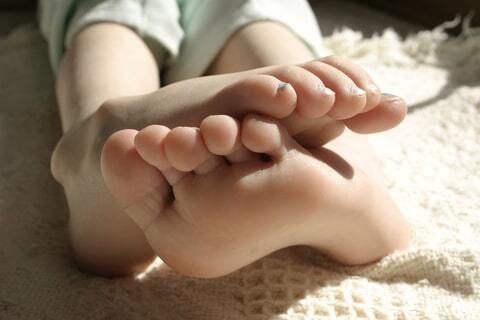
 Data Structure
Data Structure Networking
Networking RDBMS
RDBMS Operating System
Operating System Java
Java MS Excel
MS Excel iOS
iOS HTML
HTML CSS
CSS Android
Android Python
Python C Programming
C Programming C++
C++ C#
C# MongoDB
MongoDB MySQL
MySQL Javascript
Javascript PHP
PHPPhysics
Chemistry
Biology
Mathematics
English
Economics
Psychology
Social Studies
Fashion Studies
Legal Studies
- Selected Reading
- UPSC IAS Exams Notes
- Developer's Best Practices
- Questions and Answers
- Effective Resume Writing
- HR Interview Questions
- Computer Glossary
- Who is Who
5 Things Your Feet Are Telling You About Your Health
Feet often reflect the true conditions of intrinsic health and act as a mirror. Glancing at the feet is often sufficient since a few tell-tale signs indicate that all is well or something is amiss. The body is a complex organism that requires a variety of nutrients to survive well. If something is lacking, how does one know? Testing reveals all the inner secrets but the feet are also communicating visually. Not only medical professionals but laymen too can decipher the foot messages. If the indications point to something wrong, consult the doctor to sort it out and obtain remedies.

A regular life with ample exercise and ample sleep along with nutritious food keeps most diseases at bay. Avoiding fried and fatty foods is an advantage. Restrict addictions and think positively. Getting regular health check-ups may catch problems as they start and act as preventives.
1. Numbness in the feet
PAD or peripheral artery disease could be indicated by numbness with a lack of blood flowing to the area. Occasional numbness happens if the feet remain in the same position for too long like being seated on the sofa with the legs dangling. If numbness happens often, it could indicate something going wrong. In PAD, pain in the toe or foot may happen even at rest. Weak and tired legs and difficulty in walking are experienced. Cramps during walks may happen in the hip, thigh, calf, or buttock.
Numb feet are a common symptom of peripheral neuropathy connected to diabetes type 2. As a result of diabetes, blood flow to the feet suffers. Wounds take longer to heal and infections may occur.
2. Discoloration, Spots, or Lines Under the Toenails
A black toenail could indicate diabetes, anemia, heart disease, or kidney disease. Fungal infections are common because the feet are often damp. A black spot under the toenail could be the result of injury. Blood being trapped could be due to tight shoes or dropping something heavy on the foot. If such a cause is known, there is no need to worry. The trapped blood will grow out with the nail. Keep the feet clean and dry.
If it is a fungal nail infection, usually white or yellow, and turning black with debris. While keeping the toenail clean and dry, oral and cream medications may be required. Laser treatment is the most effective.
Skin cancer or melanoma is rare but could occur and requires immediate attention. The war against cancer is improving but the location should be revealed in the first place. Consultation with the dermatologist would be required.
3. Foot Pain in the Morning
Several possible reasons could be responsible. The most common causes are Achilles tendinitis, arthritis, hypothyroidism, and plantar fasciitis.
Nerves in the feet and legs get damaged by diabetic neuropathy. Along with the legs and feet, the hands may also feel numb. The digestive system and urinary tract along with the heart may face problems.
if the cause is arthritis, even the small joints ache. Along with medication, regular exercise can keep rheumatoid arthritis in check.
Another possible cause is plantar fasciitis. The elderly and the middle-aged along with the overweight suffer more. In this condition, the tissue that connects the heel and the toe gets inflamed. It is a good idea to stretch your feet before bed. Exercises to strengthen the feet also help. Ice the area and take pain medications.
The Achilles tendon connects the heel with the calf muscles, running down the leg at the back. The elderly suffer more, especially the obese with high blood pressure. Cold weather makes it worse. Deep rest helps along with icing, foot elevation, and stretching.
Hypothyroidism results in myxedema with dry thick skin that can put pressure on the tarsal tunnel and result in pain. The tarsal tunnel contains many nerves and blood vessels.
Cramps could be the cause. Stretch the feet well at bedtime. Cramps could also mean dehydration and missing dietary nutrients. Calcium, potassium, and magnesium are lacking. Eat a balanced diet and drink water at bedtime.
4. Dry Flakes on the Feet
Cracked skin on the feet and especially heels may be too common due to dryness but it could stand for something fundamentally serious in health terms. The lack of moisture often causes peeling skin. Dead skin builds up with constant shoes and socks. Regular scrubbing and exfoliation are required.
If dryness is a continuous feature of the feet, think again. Athlete’s foot, eczema, psoriasis, and hyperhidrosis are possibilities.
According to a specialist, dry skin and thick feet indicate thyroid issues. Many symptoms reflect thyroid issues and consultation with a doctor seems safer. If the skin at the heel is dry and cracked, it could indicate a thyroid condition. The hormones from the thyroid gland control several important bodily functions. Metabolism, nervous system, blood pressure, and tissue growth are controlled by the thyroid hormones.
While panic is not necessary, skin drying can reflect the weather changes. If weight gain and numb hands along with vision problems occur, it could indicate something that the doctor will rectify.
5. Wounds That do not Heal
If a sore, wound, or ulcer on the foot does not heal or keeps recurring, the possible complications are several. One may not consider it significant but it could become a problem. Sometimes a scrape or cut on the skin could transform into an ulcer. The reasons could be PAD, venous insufficiency, or peripheral neuropathy. Red blood cells are lacking. Further reasons could be skin cancers like basal cell or squamous cell carcinoma, and malignant melanoma.
Sores should be healing soon enough but if it prolongs beyond reasonable time limits, what does it mean? If it does not heal soon, the causes could be many. Diabetes results in weak blood circulation. The feet are so far from the heart. Skin cancer is a possibility.
Ulcers could get infected. If the infection persists, it may result in amputation or surgical removal of the toe or part of the foot. A large number of diabetics need such a procedure.
Take good care of the feet and don’t take them for granted. Cleanliness and hygiene are paramount. Maintain moisture and hydration at all times. Keep a watch and check out what the feet are saying. If there is something to worry about, consult the doctor without delay.

